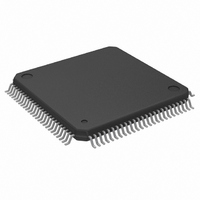HD6413007F20 Renesas Electronics America, HD6413007F20 Datasheet - Page 257

HD6413007F20
Manufacturer Part Number
HD6413007F20
Description
IC H8 MCU ROMLESS 5V 100QFP
Manufacturer
Renesas Electronics America
Series
H8® H8/300Hr
Datasheet
1.D13007F20V.pdf
(798 pages)
Specifications of HD6413007F20
Core Processor
H8/300H
Core Size
16-Bit
Speed
20MHz
Connectivity
SCI, SmartCard
Peripherals
DMA, PWM, WDT
Number Of I /o
35
Program Memory Type
ROMless
Ram Size
4K x 8
Voltage - Supply (vcc/vdd)
2.7 V ~ 5.5 V
Data Converters
A/D 8x10b; D/A 2x8b
Oscillator Type
Internal
Operating Temperature
-20°C ~ 75°C
Package / Case
100-QFP
Lead Free Status / RoHS Status
Contains lead / RoHS non-compliant
Eeprom Size
-
Program Memory Size
-
Available stocks
Company
Part Number
Manufacturer
Quantity
Price
- Current page: 257 of 798
- Download datasheet (5Mb)
7. DMA Controller
In short address mode and normal mode, an external request operates as follows. If edge sensing is
selected, one byte or word is transferred each time a high-to-low transition of the DREQ input is
detected. If the next edge is input before the transfer is completed, the next transfer may not be
executed. If level sensing is selected, the transfer continues while DREQ is low, until the transfer
is completed. The bus is released temporarily after each byte or word has been transferred,
however. If the DREQ input goes high during a transfer, the transfer is suspended after the current
byte or word has been transferred. When DREQ goes low, the request is held internally until one
byte or word has been transferred. The TEND signal goes low during the last write cycle.
In block transfer mode, an external request operates as follows. Only edge-sensitive transfer
requests are possible in block transfer mode. Each time a high-to-low transition of the DREQ
input is detected, a block of the specified size is transferred. The TEND signal goes low during the
last write cycle in each block.
Activation by Auto-Request: The transfer starts as soon as enabled by register setup, and
continues until completed. Cycle-steal mode or burst mode can be selected.
In cycle-steal mode, the DMAC releases the bus temporarily after transferring each byte or word.
Normally, DMAC cycles alternate with CPU cycles.
In burst mode, the DMAC keeps the bus until the transfer is completed, unless there is a higher-
priority bus request. If there is a higher-priority bus request, the bus is released after the current
byte or word has been transferred.
7.4.8
DMAC Bus Cycle
Figure 7.13 shows an example of the timing of the basic DMAC bus cycle. This example shows a
word-size transfer from a 16-bit two-state access area to an 8-bit three-state access area. When the
DMAC gets the bus from the CPU, after one dead cycle (T
), it reads from the source address and
d
writes to the destination address. During these read and write operations the bus is not released
even if there is another bus request. DMAC cycles comply with bus controller settings in the same
way as CPU cycles.
Rev.5.00 Sep. 12, 2007 Page 227 of 764
REJ09B0396-0500
Related parts for HD6413007F20
Image
Part Number
Description
Manufacturer
Datasheet
Request
R

Part Number:
Description:
KIT STARTER FOR M16C/29
Manufacturer:
Renesas Electronics America
Datasheet:

Part Number:
Description:
KIT STARTER FOR R8C/2D
Manufacturer:
Renesas Electronics America
Datasheet:

Part Number:
Description:
R0K33062P STARTER KIT
Manufacturer:
Renesas Electronics America
Datasheet:

Part Number:
Description:
KIT STARTER FOR R8C/23 E8A
Manufacturer:
Renesas Electronics America
Datasheet:

Part Number:
Description:
KIT STARTER FOR R8C/25
Manufacturer:
Renesas Electronics America
Datasheet:

Part Number:
Description:
KIT STARTER H8S2456 SHARPE DSPLY
Manufacturer:
Renesas Electronics America
Datasheet:

Part Number:
Description:
KIT STARTER FOR R8C38C
Manufacturer:
Renesas Electronics America
Datasheet:

Part Number:
Description:
KIT STARTER FOR R8C35C
Manufacturer:
Renesas Electronics America
Datasheet:

Part Number:
Description:
KIT STARTER FOR R8CL3AC+LCD APPS
Manufacturer:
Renesas Electronics America
Datasheet:

Part Number:
Description:
KIT STARTER FOR RX610
Manufacturer:
Renesas Electronics America
Datasheet:

Part Number:
Description:
KIT STARTER FOR R32C/118
Manufacturer:
Renesas Electronics America
Datasheet:

Part Number:
Description:
KIT DEV RSK-R8C/26-29
Manufacturer:
Renesas Electronics America
Datasheet:

Part Number:
Description:
KIT STARTER FOR SH7124
Manufacturer:
Renesas Electronics America
Datasheet:

Part Number:
Description:
KIT STARTER FOR H8SX/1622
Manufacturer:
Renesas Electronics America
Datasheet:

Part Number:
Description:
KIT DEV FOR SH7203
Manufacturer:
Renesas Electronics America
Datasheet:











